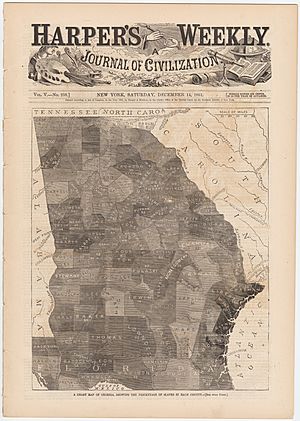History of slavery in Georgia (U.S. state) facts for kids
Slavery in Georgia was a system where people were treated as property. European colonists brought this practice to the area. Over time, it grew into large-scale plantations, especially for growing crops like cotton.
The Province of Georgia, founded by James Oglethorpe, was unique among the Thirteen Colonies. It actually banned slavery in 1735. However, this ban did not last. Slavery was made legal by a royal order in 1751. This change happened partly because of support from people like George Whitefield.
Contents
Early History of Slavery
Before Europeans arrived, Native American tribes sometimes captured people from other tribes during wars. These captives might become part of the tribe later, especially if they were children. This was different from European slavery. European slavery focused on making money, and it was based on the idea that some races were inferior. This idea was not common in Native American societies before Europeans came.
Colonial Georgia and Slavery (1526–1765)
The lives of enslaved people in Colonial America varied a lot. It depended on where they lived, what kind of work they did, and how many other enslaved people were around. It also depended on the slave owner's personality and power.
The first enslaved Africans in Georgia arrived in 1526. They came with Lucas Vázquez de Ayllón when he tried to start a colony called San Miguel de Gualdape on the Georgia coast. These enslaved people rebelled and joined with local Native American groups. This rebellion helped destroy the colony in less than two months.
Two hundred years later, Georgia was the last of the Thirteen Colonies to be founded. Its founders did not necessarily oppose slavery. However, they planned to use poor workers from Britain. They also worried about security because Spanish Florida was nearby. Spain often offered freedom to enslaved people who escaped from British colonies.
After the Georgians defeated the Spanish in the 1740s, more people wanted to allow slavery. They needed more workers for rice plantations. So, in 1751, Georgia's leaders finally allowed slavery. The number of enslaved Africans quickly grew. By the 1760s, Georgia began bringing enslaved people directly from Africa.
The Cotton Gin and Slavery (1788–1801)
Georgia played a big part in the history of American slavery because of the cotton gin. Eli Whitney invented this machine in 1793. The first demonstration of the cotton gin happened near Savannah, on a plantation owned by General Nathanael Greene.
The cotton gin made it much easier to separate cotton fibers from their seeds. This invention caused cotton to become a very important cash crop. It also greatly increased the use of enslaved labor on farms in the Southern states. The Southern economy soon relied heavily on growing cotton. This cotton was then sold to Northern and English textile factories.
The Civil War and Freedom (1850–1865)
On January 19, 1861, Georgia voted to leave the Union and join the Confederate States of America. Years later, in 1865, during his March to the Sea, Union General William Tecumseh Sherman issued Special Field Orders No. 15. This order gave about 400,000 acres of land along the Atlantic coast to formerly enslaved people. Many of the people who settled on this land and their descendants are known today as the Gullah.
Slavery was officially ended in the United States by the Thirteenth Amendment. This amendment became law on December 18, 1865. President Abraham Lincoln had already issued the Emancipation Proclamation in 1863. This proclamation declared that enslaved people in states that were rebelling against the United States were free. However, many of these areas were still controlled by the Confederacy. So, many enslaved people did not gain their freedom until the Union Army took control of those areas.
Remembering the Past
In 2002, the city of Savannah unveiled a bronze statue on River Street. This monument remembers the Africans who were brought to America as enslaved people through Savannah's port. River Street was a busy port for shipping cotton overseas. Enslaved African Americans carried cotton and rice from warehouses to the ships. They also laid the cobblestones that make up River Street.
In 2005, Wachovia Bank apologized to Georgia's African-American community. This apology was for the role of its earlier company, the Georgia Railroad and Banking Company, in using at least 182 enslaved people to build the Georgia Railroad.



